Smart Forecasting Assistant
The Smart Forecasting Assistant enables machine learning outcomes for users with little to no SPL knowledge. Introduced in version 4.3.0 of the Machine Learning Toolkit, this new Assistant is built on the backbone of the Experiment Management Framework (EMF), offering enhanced time-series forecasting abilities. The Smart Forecasting Assistant offers a segmented, guided workflow with an updated user interface. Move through the stages of Define, Learn, Review, and Operationalize to load data, build your model, and put that model into production. Each stage offers a data preview and visualization panel.
This Assistant leverages the StateSpaceForecast algorithm which persists a model using the fit command that can be used with the apply command. StateSpaceForecast is based on Kalman filters, supports incremental fit, and automatically imputes any missing values in your data. To help improve the accuracy of your forecast, this algorithm includes the ability to account for the effects of specific days that need to be treated differently.
To learn more about the Smart Forecasting Assistant algorithm, see StateSpaceForecast algorithm.
Version 4.4.0 of the Smart Forecasting Assistant supports both univariate and multivariate forecasting . Version 4.3.0 of the Smart Forecasting Assistant is limited to univariate forecasting.
Smart Forecasting Assistant Showcase
You can gain familiarity of this new Assistant through the MLTK Showcase, accessed under its own tab. The Smart Forecasting Assistant Showcase examples include:
- Forecast the Number of Calls to a Call Center
- Forecast App Logons with Special Days
- Forecast App Expenses
- Forecast App Expenses from Multiple Variables
Click the name of any Smart Forecasting Showcase to see this new Assistant and its updated interface using pre-loaded test data and pre-selected forecast parameters.
Smart Forecasting Assistant Showcases require you to click through to continue the demonstration. Showcases do not include the final stage of the Assistant workflow to Operationalize the model.
Smart Forecasting Assistant univariate workflow
Move through the stages of Define, Learn, Review, and Operationalize to draw in data, build your model, and put that model into production.
This example workflow uses the call_center.csv dataset that ships with the MLTK. You can use this dataset or another of your choice to explore the Smart Forecasting Assistant and its features before building a model with your own data.
To begin, select Smart Forecasting from the Experiments landing page and the Create New Experiment button in the top right.
Enter an Experiment Title, and optionally add a Description. Click Create to move into the Assistant interface.
Define
Use the Define stage to select and preview the data you want to use for the forecast. You can pull in data from anywhere in the Splunk platform. You can use the Search bar to modify your data in advance of using that data within the Learn step.
As an alternative to accessing data via Search, you can choose the Datasets option. Under Datasets, you can find any data you have ingested into Splunk, as well as any datasets that ship with Splunk Enterprise and the Machine Learning Toolkit. You can filter by type to find your preferred data faster.
As with other Experiment Assistants, the Smart Forecasting Assistant includes a time-range picker to narrow down the data time-frame to a particular date or date range. The default setting of All time can be changed to suit your needs. Once data is selected, the Data Preview and Visualization tabs populate.
When you are finished selecting your data, click Next in the top right, or Learn from the left hand menu to move on to the next stage of the Assistant.
Learn
Use the Learn stage to perform any preprocessing on your data, and to create your forecasting model. The Learn is made up of two menus: Initial data- search, and Smart Forecasting. The Initial data-search menu is a carry over from inputs made in the Define stage. The Smart forecasting menu is where you can make selections to customize and complete the forecasting outcome.
You can refer to the following table for details of each available field. Certain fields are required. Hovering over the question mark helper icons beside each field also provides field descriptions.
| Field name | Description |
|---|---|
| Field to forecast | Required field. Select one (univariate) or more (multivariate) numeric field to forecast. You can select a maximum of five fields to forecast. |
| Holdback period | Required field. Holdback is the number of data points held back from training to compare the forecast against known values. This comparison is done using R2 and RMSE statistics. |
| Future timespan | Required field. Pick number of days you want to forecast into the future. The further into the future the forecast, the less accurate it is likely to be. |
| Confidence interval | Required field. Specify and integer between 0 and 99, where a larger value means a greater tolerance for forecast uncertainty. Use the slider or open field to choose the value. |
| Special days field | Optional field. Accessed using the Join special time entries preprocessing step. Special days data can improve your forecast by accounting for days which should be treated differently such as Black Friday sales or IP traffic on July 4th. |
| Period | Optional field. Specify if the data has a known periodicity. The units of the period are equal to the span of the _time field. For example, hourly data may have a period of 24 (one day), whereas daily data may have a period of 7 (one week).
|
| Notes | Optional field. Use this free form block of text to track the selections made in the parameter fields. Refer back to notes to review which parameter combinations yield the best results. |
You can select a maximum of five fields from the Fields to forecast drop-down list.
Once you make field selections, click Forecast to view results. Clicking Forecast produces a written summary at the top of the page, moves the Experiment into a Draft state, and makes the View History option available. View History allows you to track any changes you make in the Learn stage.
Leveraging the StateSpaceForecast algorithm provides the option to take company or business calendar specific days into account when building your forecasting model. Include these special days in your forecast using the Join special time entries preprocessing step option. For details on how to work with data from CSV lookups, see Define a CSV lookup in Splunk Web.
The SPL button is available as a means to review the Splunk Search Processing Language being auto-generated for you in the background as you work through the Assistant.
Choose to make further adjustments to field settings here, or click Next in the top right, or Review from the left hand menu to move on to the next stage.
Review
Use the Review stage to explore the resulting model based on the fields selected at the Learn stage. The Review panels give you the opportunity to assess your forecasting results prior to putting the model into production.
Use the model statistics from R2 and RMSE to assess model accuracy and error rate. You can also choose to set a Forecasted Value date and time, an Earliest Threshold Violation alert date, as well as toggle the Confidence Interval on or off.
Navigate back to the Learn stage to make forecast adjustments, or click Save and Next to continue.
Clicking Save and Next generates a modal window that offers the opportunity to update the Experiment name or description. When ready, click Save.
Operationalize
The Operationalize stage provides publishing, alerting, and scheduled training in one place. Click Done to move to the Experiments listings page.
The Experiments listing page provides a place to publish, set up alerts, and schedule training for any of your saved Experiments across all Assistant types including Smart Forecasting.
Smart Forecasting Assistant multivariate workflow highlights
Introduced in version 4.4.0 of the MLTK, you can perform both univariate and multivariate forecasting with the Smart Forecasting Assistant. Version 4.3.0 of the Assistant is limited to univariate forecasting.
The multivariate workflow is the same as univariate in most ways. Particular screens offer some key differences associated to a multivariate workflow. Highlights of the multivariate workflow include:
| Workflow stage | Highlight |
|---|---|
| Learn | Field to forecast menu is a multi-pick of up to five fields. |
| The Evaluate view offers combined view of fields to forecast. | |
| Review | See the number of fields to forecast as well as fields by name. |
| Use the View fields menu to filter results shown. | |
| Choose to see fields in a combined or split view. | |
| Set the Earliest Threshold Violation values in one place or set individual thresholds in split view. | |
| Toggle the confidence interval on or off for the combined chart or per chart in split view. | |
| Operationalize | When setting Alerts you can choose which target field to alert on, based on the fields selected when building the Experiment. |
The maximum number of fields to forecast you can select for the Smart Forecasting Assistant is five.
Learn
Use the Learn stage to perform any preprocessing on your data, and to create your forecasting model. In the multivariate workflow, the Field to forecast menu is multi-pick up to five fields and the list of fields is populated based on your data.
Review
Use the Review stage to assess the forecast based on your selections at the Learn stage. The Review panels give you the opportunity to assess your forecasting results prior to putting the model into production.
See the total number of chosen fields to forecast as well as those fields by name in their own drop-down. Choose to review the forecast charts in a combined view of one chart or a split view. In the combined view you can set the Earliest Threshold Violations for the all fields to forecast on one screen. Settings selected are immediately reflected in the chart results. Toggle the confidence interval on or off for the entire chart using the combined chart view, or by individual chart in the split chart view.
In the split view you can set the Earliest Threshold Violations by individual fields to forecast. Settings selected are reflected in the chart results when you click Apply.
In addition to the combined and split chart view options you can also customize fields by which to review results from the View fields drop-down menu.
Operationalize
The Operationalize stage provides publishing, alerting, and scheduled training in one place. In a multivariate workflow you can choose which field to alert on, based on the fields selected when building the Experiment.
Learn more
To learn about implementing analytics and data science projects using Splunk's statistics, machine learning, built-in and custom visualization capabilities, see the Splunk for Analytics and Data Science course.
| Preprocessing machine data using MLTK Assistants | Smart Outlier Detection Assistant |
This documentation applies to the following versions of Splunk® Machine Learning Toolkit: 4.5.0, 5.0.0, 5.1.0




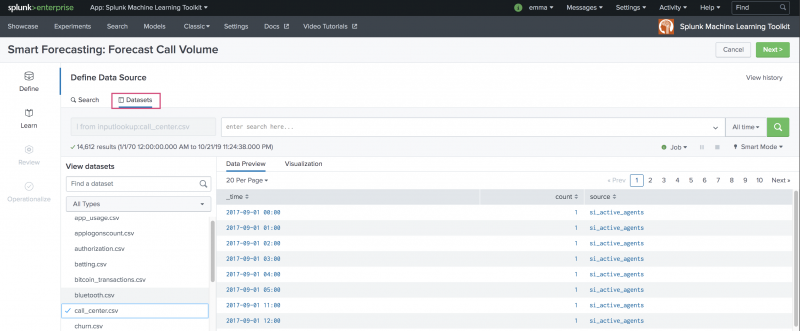
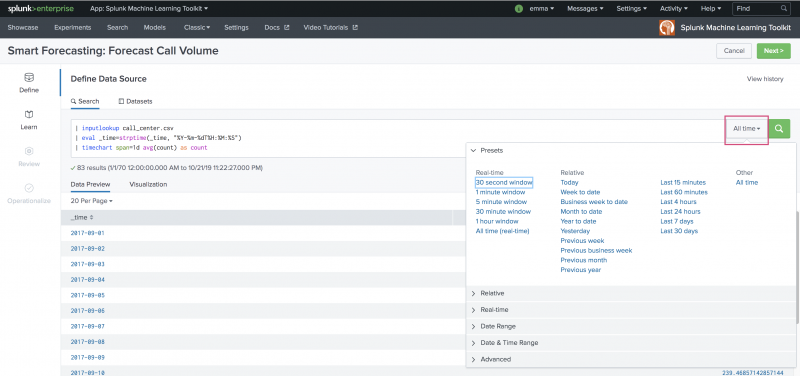

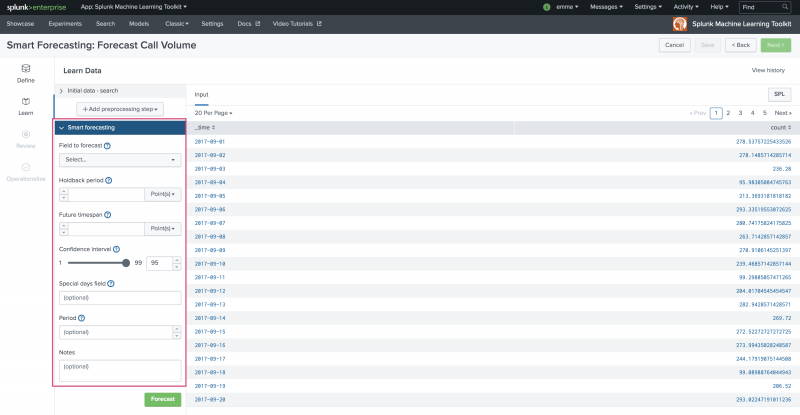
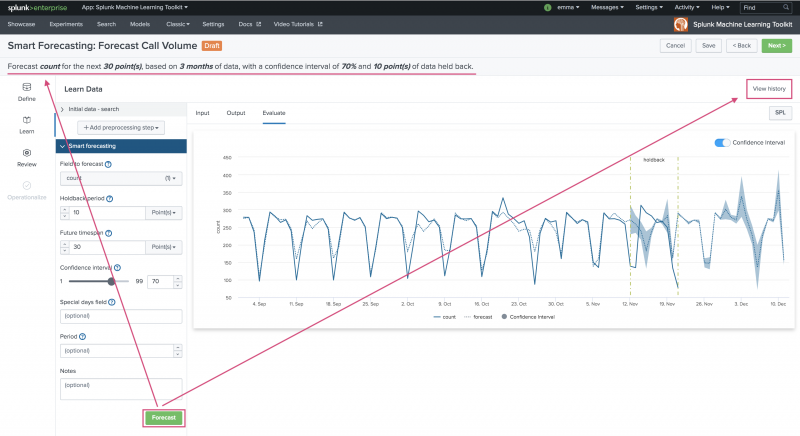
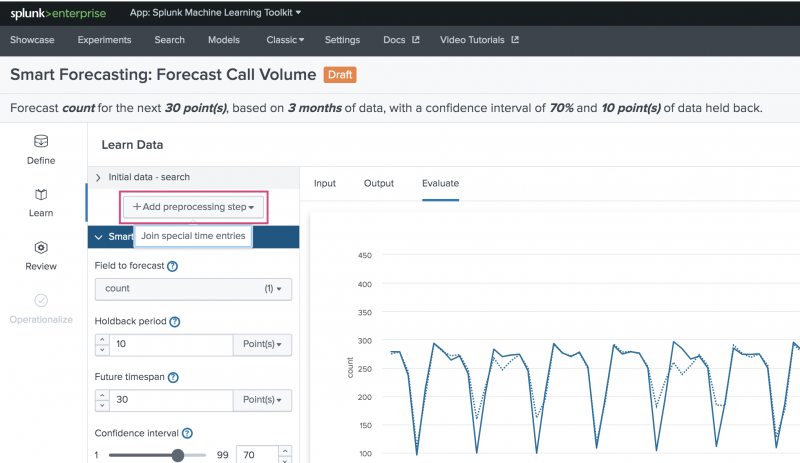

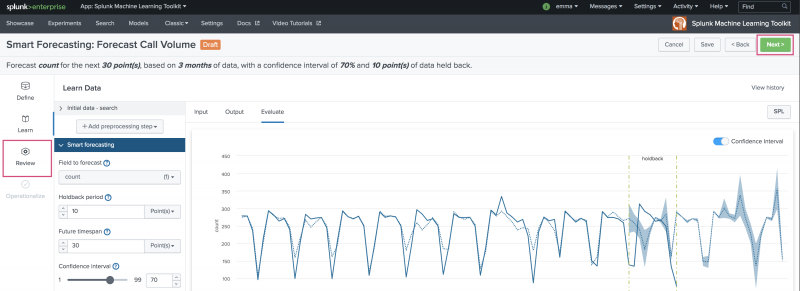




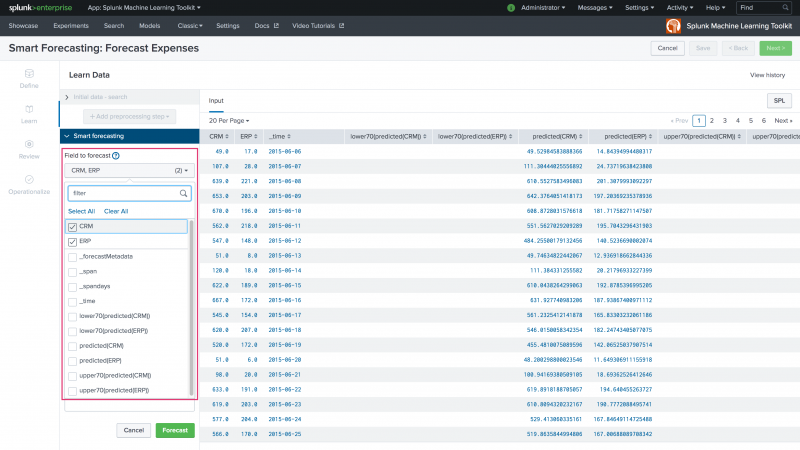
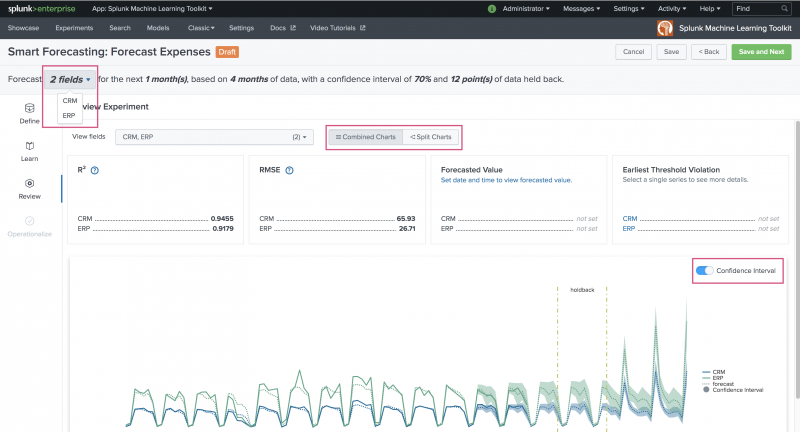
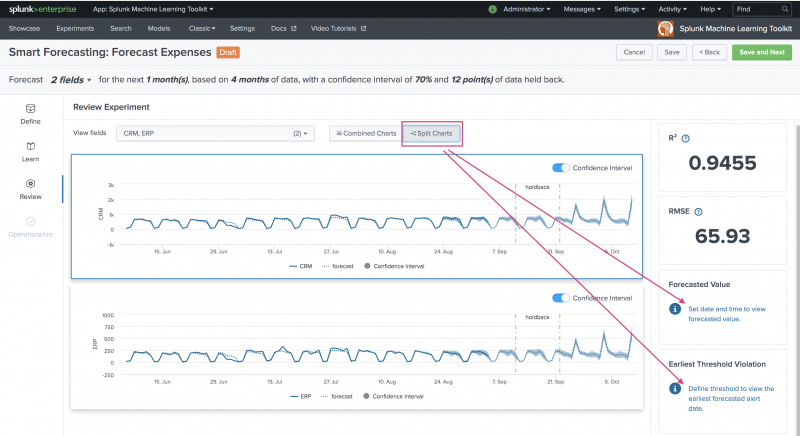
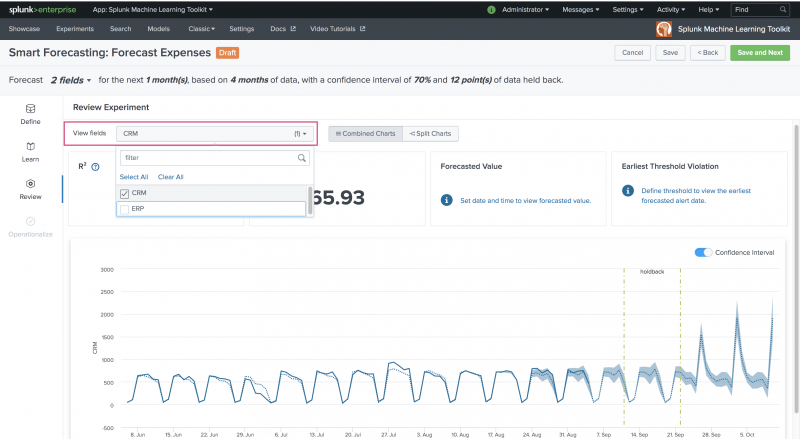

 Download manual
Download manual
Feedback submitted, thanks!